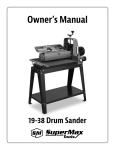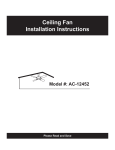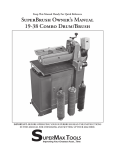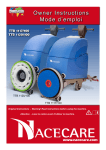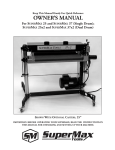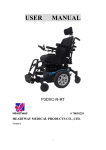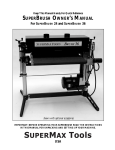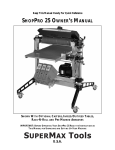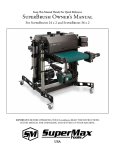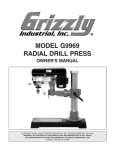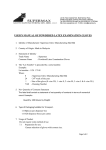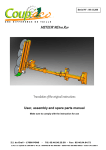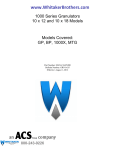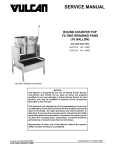Download User Manual - SuperMax Tools
Transcript
Keep This Manual Handy For Quick Reference Owner’s Manual 25-50 Drum Sander IMPORTANT: BEFORE OPERATING YOUR drum sander READ THE INSTRUCTIONS IN THIS MANUAL FOR UNPACKING AND SETTING UP YOUR MACHINE. (Shown with optional accessories) 2 25-50 Drum Owner’s Manual Congratulations Caution, Safety First You have made a wise purchasing decision by adding this machine to your tool line-up. The main purpose in inventing and developing the sander you’ve purchased was to bring a new dimension of productivity to your shop, be it large or small. Right from the start, our goal at SuperMax Tools has been to design and manufacture equipment that is capable of providing you with maximum economy, maximum utility, and maximum performance. When maintaining and operating this machine, always put safety first. For your own safety, read and understand this owner’s manual before operating this machine. Always heed and follow all normal safety precautions, including the following: • Always wear eye protection while operating the sander. • Always feed stock against the drum rotation. • Never place hands or fingers under the drum or dust cover. • Keep hands and clothing away from operating brush and drum. • Never operate the sander without its dust cover or guarding in place. • Always maintain control of stock to avoid kickback; know how to prevent it. • Always disconnect electrical power before doing any servicing or adjusting of the machine. Your 25-50 Drum Sander will pay you back many fold in the years ahead by helping you get better results in less time, start to finish. This tool incorporates a bundle of exclusive features which you will appreciate more every time you use it. All SuperMax Tools sanders feature the exclusive variable-speed power feed conveyor system. Together, they provide you with ultra-precise control, for a variety of applications. SuperMax Tools and its dealers are committed to providing you with innovative solutions, from selecting the right machine to helping you get top performance when you put it to work in your shop. Regardless of Model Identification how you take advantage of these innovations, we are confident our equipment will help bring you a giant Your 25-50 Drum sander is one of a family of machines from SuperMax Tools designed to help you step forward in precision shop productivity. achieve results comparable to industrial-size sanders at a fraction of the cost. For future reference, find the model, stock and serial numbers on the back of machine base and write them in below. Model:_________________________________ Stock Number:__________________________ Serial Number:__________________________ Date Purchased:__________________________ Dealer:_________________________________ Important: Keep This Manual Handy Please read this manual first. It was designed to help you get the most from your 25-50 Drum sander. Before unpacking or using the machine, familiarize yourself with its components, features, and basic adjustments by reviewing the following pages. You will find it an invaluable aid in setting up, operating and servicing your machine. If, after reviewing this manual, you still have a problem you can’t solve, please call your SuperMax Tools dealer. Manual Contents 3 About The SuperMax System Servicing Your SuperMax SuperBrush Nomenclature...................... 4 Unpacking Your Sander............................. 5 Adjusting Height Controls........................ 7 Leveling Table........................................... 7 Replacing Conveyor Belts........................ 15 Electrical Diagram................................... 19 Setting Up Your SuperMax Connecting Dust Collectors...................... 6 Checking For Machine Level..................... 6 Checking Height Adjustment.................... 7 Checking Drum Alignment....................... 7 Checking Conveyor Belt Tracking............. 7 Operating Your SuperMax Basic Operating Procedures....................... 8 Adjusting Tension Rollers.......................... 8 Selecting Conveyor Feed Rates.................. 9 Setting Drum Depth of Cut...................... 9 Using The Depth Gauge.......................9-10 Monthly Maintenance............................. 10 SuperMax Technical Data Parts List For Head Assembly.................. 20 Parts List For Conveyor & Motor Assembly.................................. 23 SuperMax Specifications......................... 25 Warranty Info.......................................... 26 SuperMax Accessories & Supplies.......... 27 Tips For Maximum Performance.... 10 Abrasive Selection Guide................ 12 Wrapping Abrasive Strips...................13-14 Troubleshooting Your SuperMax Troubleshooting Guide: Motors.............. 16 Troubleshooting Guide: Conveyor.......... 17 Troubleshooting Guide: Machine............ 18 FOR YOUR SAFETY: Read all instructions carefully, and note the safety cautions on the opposite page and on the back cover of this manual. 4 25-50 Drum Owner’s Manual About The 25-50 Drum Sander System This manual is designed to help familiarize you with your SuperMax sander, and to help you take advantage of its exclusive features. By understanding its major components, and how they work together, you will be able to get the most from your investment. The SuperMax system is basically made up of: 1) a height adjustment handle which raises and lowers the sanding head; 2) Depth gauge; 3) a feed rate control knob which starts feed conveyor and selects feed rate from 0-10 feet per minute; and 4) a motor starter switch which starts and stops the drive motor and sanding drum. 1 2 3 4 Fig. 1 SuperMax nomenclature. About The SuperMax System 5 Unpacking Your SuperMax 7. Using handle, raise sanding head to high position and remove packing block from under carriage arm and motor, if so equipped. (Fig 4) Your 25-50 Drum sander has been shipped mostly assembled from the factory. If any damage has occurred as a result of shipment, notify the transportation 8. Remove conveyor from packaging and place on company as soon as possible and ask them to make an sanding unit. The conveyor motor should be near immediate inspection. Ask for a damage or loss report. main motor and depth gauge. Also notify your dealer of any loss or damage during shipment. See enclosed Warranty Statement. 9. Install a flat washer, lock washer and nut on each of the two studs on outboard side of conveyor. Finger Important: To avoid problems and potential damage tighten nuts. to the machine, please read through the unpacking instructions below before proceeding to set up the 10.Install lock washer and flat washer onto two socket machine in your shop. head (or hex head bolts) and install into flange of conveyor bed on inboard (motor side). Keep 1. Assemble stand or prepare dedicated bench for support plate in place on inboard side and make sander attachment sure “fast lever” is positioned up. Fig. 4B 2. Open “Box 1” with main sanding unit. Remove cardboard liner. Open plastic bag. 11.Tighten all four nuts and bolts. 3. Cut each corner of Box 1 to fold sides flat, providing access to sanding unit. (Fig 2) 4. Remove two wood packing plates from bottom of sanding unit. (Fig 3) 5. With one or two helpers, place sanding unit on stand or bench. ( Sanding unit can be lifted using a harness through the main shroud.) Attach securely to the stand (or bench) using the four included 3/8” bolts and washers. Bolts are inserted from the bottom of stand, up into base of sander (bottom up). 6. Install knob to height adjustment handle, finger tighten nut to knob. Thread stud from knob into hand wheel (Fig 4A). Tighten nut against handwheel. Fig. 3 Remove packing plates Fig. 2 Open plastic, remove liner, cut box Fig. 4 Secure to stand, remove packing block 6 25-50 Drum Owner’s Manual Setting Up Your SuperBrush Your 25-50 Drum sander was adjusted and aligned at the factory, and it has been carefully packed for shipment. However, because of possible stress during transit, the unit should be thoroughly checked before being put to use. This section covers the preoperational checks you should make after unpacking and final assembly. Unnecessary problems can be avoided if these essential checks are performed before operating. Likewise, performing the recommended monthly maintenance procedures (page 10) will help assure trouble-free service. Connecting Dust Collectors Dust collection is necessary for all models. The 25-50 is equipped with one 4” diameter dust exhaust port at the top of the cover. Fig. 4A Install knob To attach to your collection system, install 4” hose from your collector. (See Tips For Maximum Performance, page 10 of this manual.) The minimum recommended dust collector capacities is 800 cfm. For best results, follow the recommendations of the manufacturer of your dust collection equipment. NOTE: Some applications will require more dust collection than the recommended minimum CFM. Checking Machine For Level Proper leveling of the machine is important to achieve continued maximum performance from the 25-50 Drum Sander. Fig. 4B FAST Lever “UP” 1 Fig. 5 SuperMax Components. 1. Height Adjustment Handle 2 8 2. Shroud 3 3. Depth Gauge 4. Conveyor Speed Adjustment 7 6 4 5 5. Drum ON/OFF Switch 6. Conveyor Table 7. Tension Rollers 8. Drum Carriage Fig. 5 Components Setting Up Your SuperMax 7 Height Adjustment The drum height is controlled by the height adjustment handle (Fig.5). Turning the handle raises or lowers the sanding head. One revolution of the handle raises or lowers the head 1/16 of an inch. Before operating height adjustment, be sure the packing-block is removed. It is located under the outboard end of the carriage arm (Fig. 4). Raise drum to remove. Drum Alignment Check alignment when using sanding drum. Remove abrasive from drum. Using a flat piece of wood or aluminum as a thickness gauge, insert it between the conveyor belt and the drum on the right (inboard) side of the machine (Fig. 5). Lower the sanding head so the drum just contacts the thickness gauge. Then, holding up the front tension roller, check both sides of the drum using the thickness gauge. If the drum is not parallel, loosen the four socket head cap screws (along the outboard edge of the conveyor) (Fig. 7) and raise or lower the conveyor with the 7/16” adjustment nut to achieve parallel alignment. Tighten the four socket head cap screws. conveyor belt to drift to one side of the conveyor. To adjust the belt tracking, tighten the take-up screw nut (Fig. 8 & 9) on the side the belt is drifting toward, and loosen the take-up screw nut on the opposite side. Adjusting the take-up screw nuts on both sides of the conveyor allows belt tracking adjustments to be made without affecting belt tension. Adjust the takeup screw nuts only 1/4 turn at a time. Then allow time for the belt to react to the adjustments before proceeding further. Try to avoid over-adjustments. NOTE: Make sure wrench is below surface when brushing or sanding. Fig. 6 Checking drum alignment and table height adjustment (outboard side). Table Extension Attachment Attach table extension (Fig 7, 8A) using two 5/16 x 1” socket head cap screws, two lock washers and two flat washers. Finger tighten. Align top of cast iron extension table with top of steel conveyor bed. Tighten the two socket head cap screws. Align table extension rollers with top of conveyor belt. Loosen the two small hex bolts holding the bracket for the support rollers. The rollers should be level with or slightly below the surface of the conveyor belt. Fig. 6A Checking drum alignment (inboard side). It is important to keep the surface of the rollers at or below the height of the conveyor belt Checking Conveyor Belt Tracking Conveyor belt tracking adjustments may occasionally be necessary during break-in and normal operation to compensate for belt stretching. If adjustments are necessary, follow these instructions: Belt tracking adjustments are made while the conveyor belt is running. With the conveyor unit on and set at the fastest speed setting, watch for a tendency of the Fig. 7 Adjusting drum alignment. 8 25-50 Drum Owner’s Manual Operating Your 25-50 Drum Sander Before using your Sander, review the previous pages in this manual on initial set-up and adjustment. In this section, you will learn how to operate the machine. Note that connecting the machine to an adequate dust collection system is necessary before operating the unit. Tension Roller Adjustment Spring loaded infeed and outfeed Tension Rollers (Fig. 11 & page 22) are provided to maintain downward pressure on stock being sanded and to prevent slippage of the stock on the conveyor. When properly set, the Tension Rollers should engage or raise up about 1/8” The SuperMax Drum Sanders offer considerable to accommodate the stock being sanded. control and versatility through variable feed rates and abrasive selections. Experiment with both to find the Tension Roller Pressure proper sander performance for a given application. The tension roller pressure is factory set for most applications. However, the pressure of each roller can Basic Operating Procedures be adjusted. Caution, too little pressure can result in After you have connected the machine to a dust slippage of stock on conveyor belt or kick-back. Too collection system, you are ready to begin to use the much tension can cause snipe when drum sanding. SuperMax. The basic operating procedure for the SuperMax models is as follows: 1. Set depth of cut (page 9). 2. Start sanding drum. 3. Start conveyor and select feed rate (page 10) 4. Start dust collector system. 5. Feed stock through unit. To feed stock through the SuperMax, rest and hold the stock to be sanded on the conveyor table, allowing the conveyor belt to carry the stock into the drum. Once the stock is halfway through, reposition yourself to the outfeed side of the machine to receive Fig. 8A Table Extension attachment. and control the stock as it exits the unit. Fig. 8 Hanging wrench, 1 of 2, for tracking conveyor Fig. 9 Hanging wrench 1 of 2, for tracking conveyor Operating Your SuperMax 9 To increase tension turn the tension adjusting screw clockwise ¼ revolution at a time. To decrease tension turn the adjusting screw counter-clockwise ¼ revolution at a time. (See Fig 11). Tension Roller Pressure The tension rollers are factory set for the most versatile use. Flat Surfaced Stock: If necessary to adjust tension roller contact, loosen the four socket head screws holding the tension roller brackets (Fig. 11 & 11A). Have abrasive wrapped on drum. With machine unplugged, lower sanding drum until it rests on conveyor belt. Raise drum 2 to 3 revolutions. Tighten the four socket head screws. Raise drum up, off of conveyor belt. Set drum for proper sanding height (page 11) and process stock. prevents excessive gouging, reduces the risk of burning and protects the machine from overload or stalling. The red light by the adjustment knob will come on when INTELLISAND is operating. (Fig. 11A) When the load is decreased, INTELLISAND will automatically increase the feed rate to the pre-selected speed. When finish sanding with grits finer than 80, the best finish can usually be obtained if INTELLISAND does not engage. If INTELLISAND does slow the conveyor when finish sanding, it is usually best to make another sanding pass without changing the thickness setting and sanding again. Setting Drum Depth of Cut Determining the depth of cut is the most IMPORTANT set-up procedure before operating a drum sander. It may take some experimentation to Conveyor Feed Rates determine the proper depth of cut, given the variables Selecting the proper feed rate is essential to proper of abrasive grit, type of wood, and conveyor feed rate. finish sanding. For finish sanding the best finish is Practicing on scrap before sanding a project can be usually achieved with a slow to moderate feed rate, beneficial. after the proper depth of cut has been determined. A good rule-of-thumb when sanding is to place the This allows for the most revolutions of the drum per workpiece under the drum and lower the sanding head inch of sanding. When abrasive planning, faster feed until the workpiece contacts the drum but the drum can rates can be used as long as the machine is not over still be rotated by hand. When making successive passes, stressed. Note, angling stock (Fig. 13) as it is sanded lower the sanding head no more than the thickness of will allow the most effective stock removal and the grit abrasive, I.e. 1/8-1/16 of a turn for 80 grit and least loading of the abrasives. Feeding stock straight less for finer grits. Note: one revolution of the height through yields the widest sanding capacity and least adjustment handle moves the sanding head 1/16”. noticeable scratch pattern. Using Thickness Gauge Please note; INTELLISAND will automatically adjust the conveyor feed rate if an excess load is detected. This Another method to set depth of cut is to use the thickness gauge attached to the inboard (right) side of the drum carriage (Fig 14). The gauge must be adjusted to the same height as the sanding drum with the desired abrasive. Place a flat piece of scrap stock under sanding drum and lower drum until abrasive lightly touches scrap. Without changing drum height, place scrap stock under thickness gauge. Adjust bottom of gauge by loosening large nut and rotating gauge up or down until it lightly touches scrap. Tighten the large nut. Now stock can be placed under the thickness gauge and the drum lowered until the gauge lightly touches the stock to be sanded. Thus stock does not need to be carried under Fig. 10 Operating controls. the drum to set depth of cut. 10 25-50 Drum Owner’s Manual Depth Gauge Operation The depth gauge (see Fig. 5) measures the distance between the conveyor table and the bottom of the sanding drum. The sanding head must be parallel to the conveyor bed surface. To calibrate the depth gauge, loosen the two screws holding the scale. Lower the drum (with abrasive installed) until the head touches the conveyor belt. Slide the scale to align with the pointer at the “0” mark. Tighten the two screws holding the scale. An optional DRO (digital read out) for depth is available. Fig. 12. This offers the most precise reading of sanded thickness and allows for accurate repeatability of a thickness. Great when making parts that must be an exact thickness or when Fig. 11A Tension roller height and depth gauge adjustment matching a thickness. • Check all set screws for tightness. To operate, turn ON and select standard inch “in” or • Clean drum and abrasives, if applicable. metric millimeter “mm”. Lower drum, with abrasive installed, until it touches the conveyor belt. Press Tips For Maximum Performance “zero” button to calibrate. The versatility designed into the 25-50 Drum Sander Monthly Maintenance allows it to be used for a wide-ranging variety of For best results, perform the following recommended tasks that will boost the return on your investment. Learning to use its multiple adjustments and controls maintenance procedures on a monthly basis: will allow you to fine-tune the machine for maximum • Lubricate conveyor bushings and check for results, regardless of the job to be done. The best results wear. come from experimenting with different machine • Lubricate all moving parts, such as threaded adjustments to fit the job at hand. Following is a listing rods and washers of useful tips which can help you improve performance • Clean dust from the conveyor belt. of your brush sander. • Blow dust from the motors. Dust Collection. When connecting dust collectors, remember that straight pipe will not restrict airflow as much as flexible tubing. Also, Ys and elbows will restrict airflow less than Ts. Brushing Multiple Pieces At Once. When sanding multiple pieces simultaneously, make sure to stagger (step) the pieces across the width of the conveyor belt. This provides better contact with the tension rollers. Try to only process multiple pieces of similar thickness. If there is a thickness difference, the thinner pieces can slip on the conveyor belt if they do not contact the tension rollers. When sanding high or tall stock, special care is needed to prevent tipping and slilppage. Fig. 11 Tension rollers adjustment Sanding Imperfect Stock. To avoid personal injury, take special care when sanding stock that is twisted, bowed, or otherwise varies in thickness from end to Operating Your SuperMax 11 end. If possible, support such stock as it is being sanded to keep it from slipping or tipping. Use extra roller stands, help from another person, or hand pressure on the stock, to minimize potentially hazardous situations. To operate, loosen the two bolts through the flange of the conveyor on the inboard side (motor side) of the conveyor bed. Flip “Fast Lever” down 90° (Fig 15A pg 12). Tighten the two bolts through the flange of the conveyor bed. It is a good idea to test a scrap piece Stock Feeding Angle. Some pieces, because of their before sanding good stock. If a line or ridge is still visible dimensions, will need to be fed into the machine at a after adjusting “Fast Lever” additional adjustments can 90° angle (perpendicular to the drum). However, even be made to the initial drum alignment (Page 7). a slight offset angle of the stock can provide for more To sand stock narrower than the drum, reverse the effective sanding on most stock (Fig. 13). previous steps making sure the “Fast Lever” is in the Keeping the Machine Clean. For best results, make UP position (Fig. 4B) and bolts are tight in flange of cleaning the machine a regular shop procedure. conveyor bed on inboard side. Allowing excess build-up of dust and debris can adversely affect performance, slippage on the conveyor WARNING: Do Not Re-wire machine to 220 volt belt, and/or the accumulation of material in the drum which can throw off the center of balance. Leave the dust collector on when cleaning dust from the drum. Sweep the conveyor belt after cleaning operations. If not cleaned, the conveyor belt could allow stock to slip during operation. Sanding Stock wider than drum: The 25-50 sander is equipped with a “Fast Lever” (Fig 4B pg 6) adjuster mechanism that allows easy changing of the drum alignment in relationship to the conveyor without changing the initial drum alignment. The “Fast Lever” is very useful when sanding stock wider than the drum. Sanding stock wider than the drum may require extra space between the drum and the conveyor along the outboard edge. The extra space helps prevent an overlap line or ridge from developing along the sanded part when it extends beyond the sanding drum. Fig. 13 Offset stock feeding angle. Fig. 14 Thickness gauge. Fig. 12 Depth Gauge and optional DRO 12 25-50 Drum Owner’s Manual Abrasive Selection Guide Grit Common Application 24 Grit Abrasive planing, surfacing rough-sawn boards, maximum stock removal, glue removal. 36 Grit 50 Grit Surfacing and dimensioning boards, trueing warped boards. 60 Grit Surfacing and dimensioning boards, trueing warped boards. 80 Grit Light dimensioning, removal of planer ripples. Abrasive planing, surfacing rough-sawn boards, maximum stock removal, glue removal. 100 Grit Light surfacing, removal of planer ripples. 120 Grit Light surfacing, minimal stock removal. 150 Grit Finish sanding, minimal stock removal. 180 Grit Finish sanding only, not for stock removal. 220 Grit Finish sanding only, not for stock removal. Fig. 15 Accessing inboard abrasive fastener Fig. 15A “Fast Lever” down. Operating Your SuperMax 13 Wrapping Abrasive Strips Note: When using Pre-Marked™ or Pre-Cut™ abrasives, not all of the steps below are necessary. 4. With the trailing edge of the strip properly cut, rewrap the drum and insert the tapered end through the slot in the right (inboard) end of the drum. Insert the tapered end into the inboard takeup fastener. Pull up on the clip lever to open the clip, and pull the take-up lever to the top as shown (Fig. 16G). After inserting the strip end, release the clip lever by moving your index finger toward the drum slot. This allows the clip to retain the abrasive while holding the take-up lever in an “up”position. Proper attachment of the abrasive strip to the drum is critical to achieving top performance from your SuperMax Tools drum sander. Abrasive strips do not have to be pre-measured. The end of the roll is first tapered and attached to the left (outboard) side of the drum. Then the strip is wrapped around the drum, and the second taper is made for attachment to the 5. The take-up fastener is designed to automatically right (inboard) side of the drum. To attach a strip to take up any slack caused by stretching of the the drum, follow the procedure below. abrasive strip. Important: Position the abrasive 1. Mark and cut a taper at one end of the roll as strip in the slot with sufficient room between the shown in Fig. 16. Because the tapered end should inside of the slot and the tapered end of the strip to use most of the left (outboard) slot width, its end allow it to be pulled into the drum as needed (Fig. must be trimmed (Fig. 16B and 16C). Raise the 16H). Note that not leaving enough space between clip lever on the left (outboard) side of the drum the strip and the inside of the slot will prevent the (Fig. 16D). Insert the tapered end through the slot take-up fastener from operating properly. and into the fastener so that it uses most of the 6. The abrasive strip may stretch enough in use to allow width of the slot. Release the clip lever to securely the take-up lever to reach its lowest position so it no hold the strip end in the fastener. longer is able to maintain tension on the strip (Fig. 2. Wrap the strip around the drum, being careful 16I). If this occurs, it will be necessary to reset the not to overlap the windings. The tapered cut of take-up lever by raising it, pushing the strip end into the strip end should follow the edge of the drum. the slot, and then releasing the clip lever. Continue to wrap the abrasive in a spiral fashion by Note: A sandpaper cleaning stick may be used to rotating the drum with your left hand and guiding remove deposits and help extend sandpaper life. To the strip with your right hand (Fig 16E). Successive use, operate the sanding drum with the dust cover windings of the strip should be flush with previous open. (Caution: For your own safety, always wear eye windings without any overlap. protection while performing sandpaper cleaning, and 3. Mark the trailing end of the strip where it crosses the take all precautions to avoid any contact of hands or right (inboard) end of the drum (Fig. 16F). From clothing with uncovered drums.) Hold the cleaning this point, cut a taper as was done with the starting stick against the rotating drum and move it along the edge of the strip. (The taper on the remaining roll drum surface. It is good procedure to use a shop brush can be used as the taper for the starting edge of the to remove any cleaning stick crumbs from the drums next strip to be cut.) before resuming sanding operations. SANDPAPER STRIP (ABRASIVE SIDE UP ) 16-b and Fig. 16-c Also see Fig. 12-b 12-c. Fig. 16 Marking and cutting taper on strip. CU T L INE S 15 3/4 " 3" Approx. 3" 14 25-50 Drum Owner’s Manual Fig. 16B Trim about 3” from end of cut taper. Fig. 16C Trimmed tapered end ready to install. Fig. 16D Insert tapered end into outboard slot. Fig. 16E Wrap strip around drum without overlap. Fig. 16F Mark strip where it crosses drum edge. Fig. 16G Insert tapered end into inboard slot. Fig. 16H Allow room inside slot for strip to move. Fig. 16I Reset take-up as needed as strip stretches. Operating Your SuperMax 15 Replacing Conveyor Belts To replace the conveyor belt, the conveyor assembly must be removed from the machine. Raise the drum carriage to its highest position using the height adjustment handle. Turn off power source to machine. Unplug main drive motor from receptacle (in gear motor assembly). Loosen the conveyor takeup screws (Fig. 8, 9) to relieve belt tension and slide the driven roller fully inward. Remove the two bolts (inboard side) that attach the conveyor assembly to the base (see Fig. 11A & 17). Remove the two nuts and washers (outboard side) (Fig. 7 & 18). Lift the conveyor and remove it from the sander. Stand conveyor on motor side. Avoid tearing the belt on any edges underneath the conveyor bed during removal. Reverse the procedure for re-installation. Re-install the conveyor bed to sander. Conveyor Belt Tracking: Belt tracking adjustments are made while the conveyor belt is running. After the proper belt tension is obtained (see above), turn the conveyor unit on and set it at the fastest speed setting. Watch for a tendency of the conveyor belt to drift to one side of the conveyor. To adjust the belt tracking, tighten the take-up screw nut (Fig. 8, 9) on the side the belt is drifting toward, and loosen the take-up screw nut on the opposite side. Adjusting the take-up screw nuts on either side of the conveyor allows belt tracking adjustments to be made without affecting belt tension. Note: Adjust the take-up screw nuts only 1/4 turn at a time. Then allow time for the belt to react to the adjustments before proceeding further. Avoid over-adjustments. Conveyor Belt Tension: To adjust the tension of the conveyor belt, first adjust the take-up screw nut (Fig. 8, 9) on both sides of the conveyor to obtain approximately equal tension on both sides of the belt when taut. Insufficient belt tension will cause slippage of conveyor belt on the drive roller during sanding operation. The conveyor belt is too loose if it can be stopped by hand pressure applied directly to the top of the conveyor belt. Excessive belt tension can result in bent rollers, premature wearing of the bronze bushings or conveyor belt Fig. 17 Inboard conveyor attachment bolts. Fig. 18 16 25-50 Drum Owner’s Manual Troubleshooting Your SuperBrush Any operating problems with the SuperMax will likely occur most often during the period that you are becoming familiar with its components and their adjustments. If you are experiencing a problem affecting the machine’s brushing performance, check the following listings for potential causes and solutions; it may also pay to review the previous sections in this manual on setting up and operating your machine. Troubleshooting Guide: Motors ProblemPossible Cause Solution Motors do not start. 1. Main power cord unplugged from receptacle. Plug in primary power cord. 2. Drum motor cord unplugged from receptacle near power-feed motor. Plug in drum motor cord at receptacle on machine if so equipped (Fig. 5). 3. Circuit fuse blown or circuit breaker tripped. Replace fuse or retrip breaker (after determining cause). Drum motor overloads. 1. Inadequate circuit. Check electrical requirements 2. Machine overloaded. Use slower feed rate; reduce depth of cut. Conveyor motor oscillates. 1. Motor not properly aligned. Loosen housing bolts, run motor, retighten bolts. 2. Shaft collar or bushing worn. Replace shaft collar or bushing 3. Drive roller bent. Replace drive roller Drum motor or conveyor 1. Excessive depth of cut. gear motor stalls. Reduce depth of cut; reduce feed rate. Troubleshooting Your SuperMax 17 Troubleshooting Guide: Conveyor ProblemPossible Cause Solution Conveyor rollers run 1. Shaft coupling loose. intermittently. Align shaft flats of gear motor and drive roller; tighten shaft coupling set screws. Conveyor belt slips on drive roller. Adjust belt tension (page 15). 1. Improper conveyor belt tension. 2. Excessive depth of cut. Reduce depth of cut; reduce feed rate. Stock slips on conveyor belt. 1. Excessive depth of cut. Reduce depth of cut. 2. Tension rollers too high. Lower tension rollers (page 8-9). 3. Excessive feed rate. Reduce feed rate. 4. Dirty or worn conveyor belt. Clean or replace conveyor belt. Conveyor belt tracks 1. Belt out of adjustment. to one side, or oscillates from side to side. 2. Drive or driven conveyor belt rollers misaligned. Readjust belt; (page 15). 3. Conveyor table not flat and square. Readjust by leveling machine 4. Conveyor belt worn. Replace conveyor belt (page 15). 5. Drive roller worn or damaged. Replace drive roller. 6. Roller bushings elongated due to excessive wear. Replace bushings. Readjust 18 25-50 Drum Owner’s Manual Troubleshooting Guide: Machine ProblemPossible Cause Solution Drum height adjustment 1. Improper adjustment of works improperly. height control. Readjust height control Knocking sound 1. Bearing worn. while running. Replace bearing Contact dealer Sniping of wood (gouging near end of board). 1. Inadequate support of stock. Use roller stands to support stock. 2. Conveyor drive or driven rollers higher than conveyor bed. Readjust rollers 2. Exessive tension roller pressure Adjust rollers (page 8-9) Burning of wood. 1. Feed rate too slow. or melting of finish 2. Excessive depth of cut Increase feed rate. Gouging of wood. 1. Conveyor belt is too loose. Adjust belt tension. 2. Excessive depth of cut. Reduce depth of cut. 3. Wood slipping on conveyor due to lack of contact. Use alternate feeding procedure Reduce depth of cut, TO GEAR MOCONVEYOR Wiring Diagram 19 20 25-50 Drum Owner’s Manual Part List: Drum Head Assembly HEAD ASSEMBLY Index Part No. No. Description Size Qty. 1 .......... 480DS-101.................... Motor....................................................... ..................................................1 ............ 480DS-101MFC ............ Motor Fan Cover..................................... ..................................................1 2 .......... 480BS-134 .................... Strain Relief, motor ................................. 7N-2 ..........................................1 3 .......... 480DS-103.................... Main Cord, Motor to Control Box ............ ..................................................1 4 .......... 480BS-104 .................... Key.......................................................... 3/16”SQx3/4” ............................2 5 .......... 480BS-105 .................... Nylon Insert Lock Nut ............................. 5/16”-24 ....................................4 6 .......... 480BS-106 .................... Flat Washer ............................................ 5/16” .......................................10 7 .......... 480BS-107 .................... Oilite Washer .......................................... ..................................................8 8 .......... 480BS-108 .................... Motor Plate ............................................. ..................................................1 9 .......... 480BS-109 .................... Set Screw ............................................... #8-32x1/4” ................................1 10 ........ 480BS-110 .................... Hex Cap Screw....................................... 5/16”-18x1-1/4” .........................6 11 ........ 480BS-111 .................... Lock Washer ........................................... 3/8” ...........................................4 12 ........ 480BS-112 .................... Socket Head Cap Screw ........................ 3/8”-16x1-1/2” ...........................4 13 ........ 480BS-113 .................... Set Screw ............................................... 1/4”-20x1/4” ..............................5 14 ........ 480BS-114 .................... Couping .................................................. ..................................................2 15 ........ 480BS-115 .................... Couping Spider ....................................... ..................................................1 16 ........ 480BS-116 .................... Height Plate ............................................ ..................................................1 17 ........ 480BS-117 .................... Screw, Phil Pan Head............................. M4x0.7x6 ................................11 18 ........ 480BS-118 .................... Label, Depth Gauge (inch) ..................... ..................................................1 19 ........ 480BS-119 .................... Depth Gauge Pointer .............................. ..................................................1 20 ........ 480BS-120 .................... Knob ....................................................... ..................................................1 21 ........ 480BS-121 .................... Height Adjustment Handle ...................... ..................................................1 22 ........ 480BS-122 .................... Nylon Insert Lock Nut ............................. 5/8”-11 ......................................1 23 ........ 480BS-123 .................... Height Adjustment Screw ....................... ..................................................1 24 ........ 480BS-124 .................... E-Ring ..................................................... E12 ...........................................1 25 ........ 480BS-125 .................... Thrust Bearing ........................................ 51103........................................1 26 ........ 480BS-126 .................... Shroud .................................................... ..................................................1 27 ........ 480BS-127 .................... Stud ........................................................ ..................................................4 28 ........ 480BS-128 .................... Hex Cap Screw....................................... 3/8”-16x1-1/4” ...........................4 29 ........ 480BS-129 .................... Flat Washer ............................................ 3/8” ...........................................8 30 ........ 480BS-130 .................... Hinge ...................................................... ..................................................2 31 ........ 72550-131..................... Dust Cover .............................................. ..................................................1 32 ........ 480BS-132 .................... Handle .................................................... ..................................................1 33 ........ 480BS-133 .................... Pan Head Machine Screw ...................... #8x1/2” .....................................2 34 ........ 480DS-134.................... Lock Washer ........................................... M3.............................................2 35 ........ 480BS-135 .................... Dust Cover Latch .................................... ..................................................1 36 ........ 480DS-136.................... Phillips Flat Head Screw......................... M3x0.5x10 ................................2 37 ........ 72550-137..................... Sanding Drum ......................................... ..................................................1 38 ........ 480DS-138.................... Nylon Insert Lock Nut ............................. M3x0.5 ......................................2 39 ........ 480DS-139.................... Inboard Abrasive Fastener ..................... ..................................................1 40 ........ 480DS-140.................... Outboard Abrasive Fastener .................. ..................................................1 41 ........ 480DS-141.................... Carriage Bolt ........................................... 5/16”-18x1” ...............................4 42 ........ 480DS-142.................... Bearing ................................................... 6205ZZ .....................................2 43 ........ 480DS-143.................... C-Ring..................................................... S25 ...........................................2 44 ........ 72550-144..................... Drum Carriage ........................................ ..................................................1 45 ........ 480BS-145 .................... Flat Washer ............................................ 1/4” ...........................................5 46 ........ 480BS-146 .................... Round Socket Head Cap Screw ............. 1/4”-20x1” .................................4 47 ........ 480BS-147 .................... Flat Washer ............................................ 5/16” .........................................4 48 ........ 480DS-148.................... Bearing Seat ........................................... ..................................................2 49 ........ 480BS-149 .................... Hex Cap Screw w/ Washer..................... #10-24x3/8” ..............................2 50 ........ 480BS-150 .................... Dust Cover Catch ................................... ..................................................1 SuperMax Head Assembly Parts List 21 Index Part No. No. Description Size Qty. 51 ........ 480BS-151 .................... Stud ........................................................ ..................................................1 52 ........ 480BS-152 .................... Spring ..................................................... ..................................................1 53 ........ 30-1205 ......................... Tension Roller ........................................ ..................................................2 54 ........ 480BS-154 .................... Bushing, Oilite ........................................ ................................................10 55 ........ 480BS-155 .................... Tension Roller Bracket, Inner Left .......... ..................................................1 56 ........ 480BS-156 .................... Screw ...................................................... #8-32x1” ...................................4 57 ........ 480BS-157 .................... Spring, Tension Roller ............................ ..................................................4 58 ........ 480BS-158 .................... Tension Roller Bracket, Inner Right ....... ..................................................1 59 ........ 480BS-159 .................... Pad, Bracket-Tension Roller .................. ..................................................2 60 ........ 480BS-160 .................... Bracket.................................................... ..................................................2 61 ........ 480BS-161 .................... Plate........................................................ ..................................................1 62 ........ 480BS-162 .................... Base........................................................ ..................................................1 63 ........ 480BS-163 .................... Adjusting Plate........................................ ..................................................1 64 ........ 480BS-164 .................... Adjusting Rod ......................................... ..................................................1 65 ........ 72550-165..................... Height Adjusting Plate ............................ ..................................................1 67 ........ 480BS-167 .................... Lock Washer ........................................... 5/16” .........................................7 68 ........ 480BS-168 .................... Spring ..................................................... ..................................................3 69 ........ 480BS-169 .................... Nylon Insert Lock Nut ............................. 1/4”-20 ......................................1 70 ........ 480DS-170.................... Socket Head Cap Screw ........................ M8x1.25x40 ..............................1 71 ........ 480DS-171.................... Hex Nut w/ Washer................................. 5/16”-18 ....................................4 72 ........ 480DS-172.................... Localization Block ................................... ..................................................1 73 ........ 480DS-173.................... Hex Nut ................................................... M12x1.75 ..................................1 74 ........ 480DS-174.................... Set Bolt ................................................... ..................................................1 77 ........ 480BS-177 .................... Hex Cap Screw....................................... 3/8”-16x3/4” ..............................4 79 ........ 480BS-179 .................... Tension Roller Bracket, Outer Right ....... ..................................................1 80 ........ 480BS-180 .................... Tension Roller Bracket, Outer Left ......... ..................................................1 81 ........ 480BS-181 .................... E-Ring ..................................................... E5 .............................................1 84 ........ A01-24-004 ................... Label ....................................................... ..................................................1 85 ........ 480BS-185 .................... Height Direction Label ............................ ..................................................1 86 ........ 480BS-186 .................... Maintenance Label ................................. ..................................................1 87 ........ 480BS-187 .................... Warning Label ........................................ ..................................................1 92 ........ 635DS-273.................... Abrasive Strip ......................................... #80............................................1 93 ........ 72550-193..................... Extension Table ...................................... ..................................................1 94 ........ 72550-194..................... Roller, Extension Table .......................... ..................................................3 95 ........ 480BS-237 .................... Bracket, Extension Table........................ ..................................................3 96 ........ 72550-196..................... Round Socket Head Cap Screw ............. 5/16”-18x1” ...............................6 22 25-50 Head Assembly Part List: Conveyor And Motor Assembly 25-50 Drum Sander Owner’s Manual 23 CONVEYOR & MOTOR Index Part No. No. Description Size Qty. 1 ......... 480BS-201 .................... Gear Motor .............................................90 VDC ....................................1 2 ......... 480DS-202 .................... Strain Relief, Power Cord .......................6P3-4 .......................................1 3 ......... 480DS-203 .................... Power Cord ..............................................................................................1 4 ......... 480BS-204 .................... Flat Washer ............................................5/16” ........................................4 5 ......... 480BS-205 .................... Socket Head Cap Screw .........................#10-32x1/2”..............................4 6 ......... 480BS-206 .................... Tracker Kit (optional) ...............................................................................2 7 ......... 480BS-207 .................... Knob ........................................................................................................1 8 ......... 480BS-208 .................... Speed Adjustment Label ..........................................................................1 9 ......... 480BS-209 .................... Wiring Guard ...........................................................................................1 10 ....... 480DS-210 .................... Controller .................................................................................................1 11 ....... 480DS-211 .................... Control Housing Bracket ..........................................................................1 12 ....... 480BS-212 .................... Pan Head Self-Tapping Screw ................5/32”x1/2”.................................2 13 ....... 480DS-213 .................... Receptacle, Main Cord ............................................................................1 14 ....... 480BS-214 .................... Screw .....................................................#10-32x1/2”..............................1 15 ....... 480BS-215 .................... Washer, Lock-Int. Tooth .........................#10...........................................2 16 ....... 480BS-216 .................... Hex Nut...................................................#10-32 .....................................2 17 ....... 480BS-217 .................... Screw, Hex Head-Slotted........................#10-32x3/8”..............................5 18 ....... 480BS-218 .................... Screw, Phil Pan Head .............................#6-32x1/2” ................................2 19 ....... 480BS-219 .................... Switch, ON/OFF.......................................................................................1 20 ....... 480BS-220 .................... Coupler, Shaft ..........................................................................................1 21 ....... 480BS-113 .................... Set Screw ...............................................1/4”-20x1/4” .............................2 22 ....... 480BS-222 .................... Bracket, Base- Controller .........................................................................1 23 ....... 480BS-223 .................... Cover, Base-Control Housing ..................................................................1 24 ....... 480BS-224 .................... Hex Cap Screw .......................................1/4”-20x3/4” ........................... 12 25 ....... 480BS-225 .................... Washer, Wave ........................................1/4” ..........................................4 26 ....... 480BS-145 .................... Flat Washer ............................................1/4” ..........................................4 27 ....... 480BS-227 .................... Bracket, Take Up-Slide ............................................................................2 28 ....... 480BS-154 .................... Bushing, Oilite. ........................................................................................4 29 ....... 480BS-229 .................... Roller, Driven ...........................................................................................1 30 ....... 480BS-230 .................... Wrench ....................................................................................................2 31 ....... 480BS-231 .................... Hex Nut...................................................1/4”-20 .....................................2 32 ....... 480BS-232 .................... Washer, Lock-Int. Tooth .........................1/4” ..........................................2 33 ....... 480BS-233 .................... Screw, Round Head- Slotted ..................1/4”-20x1-3/4” ..........................2 34 ....... 480BS-234 .................... Bracket, Take Up-Base ............................................................................2 35 ....... 480BS-167 .................... Lock Washer ...........................................5/16” ........................................4 36 ....... 480BS-236 .................... Roller, Drive .............................................................................................1 37 ....... 480BS-237 .................... Bracket, Support-Drive Roller ..................................................................1 38 ....... 480BS-238 .................... Bed, Conveyor .........................................................................................1 39 ....... 480BS-239 .................... Socket Head Cap Screw .........................5/16”-18x3/4” ...........................2 40 ....... 480DS-240 .................... Belt Conveyor, Abrasive (Not Shown) ......................................................1 41 ....... 480BS-204 .................... Flat Washer ............................................5/16” ........................................1 42 ....... 480BS-242 .................... Hex Nut...................................................5/16“-24 ...................................1 43 ....... 480BS-243 .................... Slotted Set Screw ...................................#8-36x5/16”..............................1 44 ....... 480BS-244 .................... Strain Relief, Gear Motor ........................6N-4 .........................................1 45 ....... 480BS-245 .................... Hex Nut...................................................5/16”-18 ...................................2 24 SuperMax 25-50 Conveyor & Motor 25-50 Drum Sander Owner’s Manual 25 25-50 Specifications Warranty: Two years on parts and labor, limited; Manufacturer’s warranties on conveyor belts, brush heads and abrasives. Sanding Capacity: Maximum Width: 50” (two passes) Minimum Length: 2-1/4” (varies with application) Maximum Thickness: 4” typical (varies with application) Minimum Thickness: 1/32” typical (varies with application) Dimensions: Length – 36” Width – 47” Height – 24” without stand Drum: 5” diameter 1750 RPM Dust Hood: Hinged back with 4” vacuum port Height Adjustment: 1/16” per revolution, Depth Gauge included Conveyor Motor: Direct drive D.C. motor Infinitely variable 0–10 feet-per-minute Drive Motor (TEFC): 1-3/4 HP Continuous-duty Power Requirements: 110 Volt, Single Phase 20 amp service Shipping Weight: 277lbs. (weight varies on how equipped) 2 boxes 26 Warranty 2 YEAR WARRANTY Limited warranty. We will provide all replacement parts which are found to be defective in materials or workmanship. Manufacturers’ warranties on conveyor belts. Supply Checklist 27 Supply Checklist 25-50 Options: Accessories: Item # Description Qty. 71938-CL Closed Stand, includes locking wheels 71938-OP Open Stand 98-0130 Caster Set: Heavy duty, roll & swivel lock (used with open stand). 71938-7 Infeed/Outfeed Tables 71938-DRO DRO (digital read out) depth gauge Conveyor Belts: Item # Description Qty. 60-0322 Type 1: 100 grit abrasive surface with reinforced backing 61-1003 Type 2: Polyurethane textured surface with monofilament backing Drum Abrasives: Item # Description 60-25-036 36 Grit: SuperMax 25-50 Combo - 3-Wraps in Box 60-25-060 60 Grit: SuperMax 25-50 Combo - 3-Wraps in Box 60-25-080 80 Grit: SuperMax 25-50 Combo - 3-Wraps in Box 60-25-100 100 Grit: SuperMax 25-50 Combo - 3-Wraps in Box 60-25-120 120 Grit: SuperMax 25-50 Combo - 3-Wraps in Box 60-25-150 150 Grit: SuperMax 25-50 Combo - 3-Wraps in Box 60-25-180 180 Grit: SuperMax 25-50 Combo - 3-Wraps in Box 60-25-220 220 Grit: SuperMax 25-50 Combo - 3-Wraps in Box For information and supplies call SuperMax Tools (888) 454-3401 or visit www.SuperMaxtools.com. Qty. Caution: Important Safety Information Keep This Manual Handy For Quick Reference For Safe Sanding Operation, Follow These Guidelines: Become Familiar With the Proper Operational procedures n for using this Machine. n Always be safety conscious when operating the machine. n always wear n always eye protection while operating the sander. feed stock against the rotation of the drum n never place hands under the drum or dust cover. n never operate without its dust cover or guards in place. n keep hands and clothing away from operating drum and coupler. n always maintain control of stock to avoid kickback; know how to prevent it. n always disconnect electrical power before performing any servicing or adjustment of the machine. n do not modify this machine: modifications are done at the owner’s risk and also will void the manufacturer’s warranty. n for customer service and questions about the operation or maintenance of this machine, please call your authorized SUPERMAX dealer. n IMPORTANT: BEFORE OPERATING YOUR SUPERMAX READ THE INSTRUCTIONS IN THIS MANUAL FOR UNPACKING AND SETTING UP YOUR MACHINE. Part No. 92-2550 © Copyright 2013




























